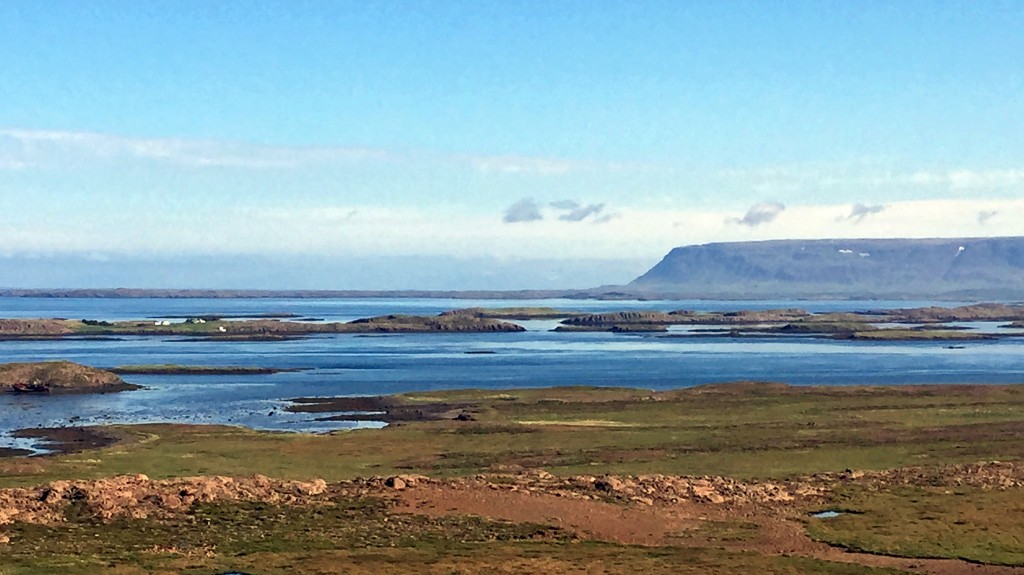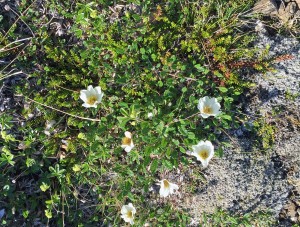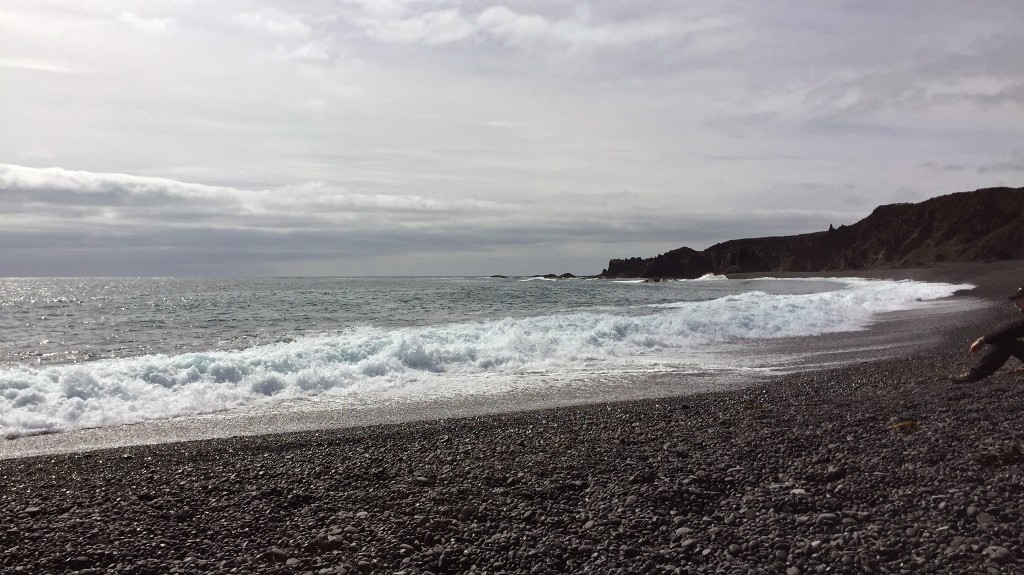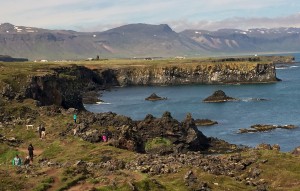
Today was a huge day, the first of two on the Snæfellsnes peninsula in western Iceland. This has long been considered one of the most scenic areas of Iceland, a must-see if you visit the country.
After an excellent breakfast at Seljaland, we set out on Highway 54. The Snæfellsnes peninsula juts 100 km into the Atlantic, and the road follows the coastline all the way out and back. Along the way we made numerous stops at beaches, waterfalls, and hiking areas.
Dominating the landscape throughout our journey was the Snæfellsjökull glacier, a volcanic glacier set near the end of the peninsula. The volcano is famous as the entrance underground in Jules Verne’s Journey to the Center of the Earth. Although Snæfellsjökull is one of Iceland’s smaller glaciers, it seemed enormous. As we traveled Hwy. 54, we saw this glacier from every possible angle, with cloud cover and without.
In order, here are the places we saw:
Skogarstrond, overlooking Hvammsfjord. True to its name, which means “forest beach,” this is the coastal area at the entry to the north side of Snæfellsnes. Although the area used to be agricultural, it is now the location for a lot of summer homes. In Hvammsfjord are countless numbers of islands. Farmers put sheep on those islands to graze all summer, then collect them in the winter. Legend has it that the islands were created by trolls trying to dig into the West Fjords peninsula in northwest Iceland to separate it from the mainland. They took the excess dirt and dumped it in Hvammsfjord to create the islands – but they lost track of time and turned to stone when the sun came up.
We made a photo stop at Skogarstrond. I got photos of moss campion, a moss cluster with a tiny pink flower, and mountain avens, Iceland’s national flower that looks like a small daisy. We also saw an example of solifluction, a wave pattern created in the sand when the cycle of freezing and thawing separates big rocks from small rocks and dirt. We also got a view of the town of Stykkisholmur, which we will visit tomorrow.
Álftafjörður, or fjord of the swans. It was easy to see where this fjord got its name – dozens of swans were swimming there as we drove by. We got some beautiful photos of mountains reflected in water.
Kolgrafafjordur. This fjord is frequented by orcas who follow huge schools of herring in search of something to eat. We stopped near a bridge under which orcas swim into the fjord. Twice in recent years the area has experienced huge herring kills caused by low oxygen. No one knows exactly why this happened, but it involved 25,000 and 30,000 tons of fish worth millions of dollars.
Kirkjufell and Kirkjufellsfoss. Kirkjufell, or “church mountain,” and its accompanying waterfall are two of the most photographed landmarks in Iceland. The mountain is 463 m (1519 ft) high. The waterfall has trails all around that people can climb to see it from different angles. We spent about 45 minutes there climbing and taking photos, along with several busses full of tourists.
Near Kirkjufell is Kvíabryggja, the prison where Iceland’s bankers are serving time. Iceland is the only country to send the bankers who caused the 2008 financial crash to jail. The prison is a working farm where bankers are expected to do chores. It is minimum security, bound mainly by the frigid river that sets it off from the mainland. Much to the frustration of Icelanders, the bankers were given refurbished cells and catered meals and allowed to ride bicycles around prison grounds. Last year two prisoners escaped.
Olafsvik, or “Olaf’s Bay,” a small fishing and tourist town of about 1,100 people. Dominating the skyline is a modern church designed to look like a Viking ship. We walked around on the shoreline and saw where fishing and pleasure boats were docked.
Gufuskalar, a coastal area that contains both modern structures, with a 412 m (1351 ft) radio tower, the tallest manmade structure in Europe, and ancient structures in a series of houses built out of lava rocks from the Snæfellsnes volcano dating back to the 14th century. The houses were used to store and dry fish for international trade during the Middle Ages. 134 houses were constructed, 12 of which are still standing. We ate lunch in this area and were able to explore the ruins and houses still intact.
Djupalonssandur, a black pebble beach near the old fishing town of Dritvik on the end of the Snæfellsnes peninsula. The beach is made entirely of pebbles, which makes walking somewhat challenging as your feet sink into the pebbles with each step. Four huge stones mark the entrance to the beach. These are what men would have to lift to qualify to work on a fishing boat. We were allowed to collect two rocks each from the beach. We were also quite close to Snæfellsjökull, so I took the opportunity to get more photos.
Hellnar to Arnarstapi. Between these two towns is an amazing hiking trail along the coast. Although it’s only 2.5 km (1.5 mi) long, it winds up and down cragged cliffs and gives you such spectacular views of rocky islands, sea caves and stone arches that it will take a couple of hours to get through.
Thomas and I hiked the trail carrying on a conversation about agriculture around the world in between snapping photos. Sea birds are everywhere, and we found a lot of eggs that looked as if they had been broken and the contents eaten by foxes. We also found a few bird legs and wings. Among the most notable landmarks are the Badstofa sea caves, known for their unique light refraction and colorful interior, and the Gatklettur sea arch. This was one of the highlights of my trip.
Budir, a white sand beach dotted with large black rocks made of hardened lava. This beach is white sand from the sea shells that have washed ashore and broken up over the millennia. Because the huge lava rocks are still intact, the beach does not have black sand. A notable landmark is the black church.
Ytri-Tunga, known for its colony of seals. We saw one seal playing in the water about 100 feet offshore, with several other seals resting on the rocks behind him. We also saw two families of eider ducks and an oyster catcher dipping into the water for food near shore. Signs had a discussion of the seal hunt in Iceland, which is not commercial, though I did see sealskin items for sale in various places.
Finally after such a long day of sightseeing, we got to our evening destination, the cottages at Snorrastadir Farm near the Eldborg crater. I was more than happy to roll out my sleeping bag in the back bedroom rooming with Emily for the night.
Here is a huge gallery of more photos from the day. Click any photo to enlarge it.
- Out of the way, sheep!
- Hvammsfjord islands
- Hvammsfjord islands
- Solifluction
- Flower
- Church at Grof, Iceland.
- Reflective scenery at Álftafjörður
- Grof, Iceland, nestled in the mountains.
- KIrkjufellsfoss
- KIrkjufellsfoss
- KIrkjufellsfoss
- Kirkjufell selfie
- KIrkjufellsfoss selfie
- Goats at Olafsvik
- Radio tower at Gufuskalar
- Djupalonssandur black pebble beach
- View from Djupalonssandur black pebble beach
- View from Djupalonssandur black pebble beach
- Rocks collected at View from Djupalonssandur black pebble beach
- Snæfellsjökull from the west
- Snæfellsjökull from the west
- Arnarstapi to Hellnar hike sign
- Arnarstapi to Hellnar hike
- Can you imagine living here?
- Arnarstapi to Hellnar hike
- Arnarstapi to Hellnar hike
- Snæfellsjökull from the south
- Snæfellsjökull from the south
- Arnarstapi to Hellnar hike
- Birds on the Gatklettur natural arch
- Birds on the Gatklettur natural arch
- Arnarstapi to Hellnar hike
- Arnarstapi to Hellnar hike
- Black church at Budir
- Anjellica at Budir beach
- Anjellica at Budir beach
- Shells collected on Budir beach by Lauren
- Hatched fish eggs on Budir beach

















































